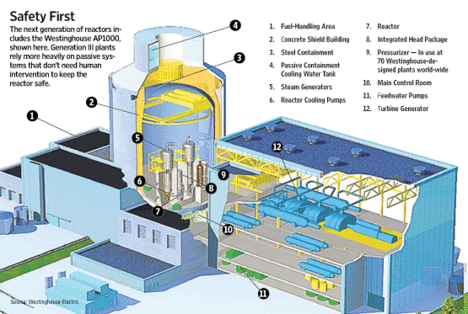 Source of graphic: online version of the WSJ article quoted and cited below.
Source of graphic: online version of the WSJ article quoted and cited below.
(p. R1) Researchers are working on reactors that they claim are simpler, cheaper in certain respects, and more efficient than the last generation of plants.
Some designs try to reduce the chance of accidents by automating safety features and minimizing the amount of hardware needed to shut down the reactor in an emergency. Others cut costs by using standardized parts that can be built in big chunks and then shipped to the site. Some squeeze more power out of uranium, reducing the amount of waste produced, while others wring even more energy out of spent fuel.
“Times are exciting for nuclear,” says Ronaldo Szilard, director of nuclear science and engineering at the Idaho National Lab, a part of the U.S. Energy Department. “There are lots of options being explored.”
. . .
(p. R3) As a whole, . . . , the U.S. nuclear industry has a solid safety record, and the productivity of plants has grown dramatically in the past decade. The next generation of reactors so-called Generation III units is intended to take everything that’s been learned about safe operations and do it even better. Generation III units are the reactors of choice for most of the 34 nations that already have nuclear plants in operation. (China still is building a few Gen II units.)
“A common theme of future reactors is to make them simpler so there are fewer systems to monitor and fewer systems that could fail,” says Revis James, director of the Energy Technology Assessment Center at the Electric Power Research Institute, an independent power-industry research organization.
The current generation of nuclear plants requires a complex maze of redundant motors, pumps, valves and control systems to deal with emergency conditions. Generation III plants cut down on some of that infrastructure and rely more heavily on passive systems that don’t need human intervention to keep the reactor in a safe condition reducing the chance of an accident caused by operator error or equipment failure.
For example, the Westinghouse AP1000 boasts half as many safety-related valves, one-third fewer pumps and only one-fifth as much safety-related piping as earlier plants from Westinghouse, majority owned by Toshiba Corp. In an emergency, the reactor, which has been selected for use at Southern Co.’s Vogtle site in Georgia and at six other U.S. locations, is designed to shut down automatically and stay within a safe temperature range.
For the full story, see:
REBECCA SMITH. “The New Nukes; The next generation of nuclear reactors is on its way, and supporters say they will be safer, cheaper and more efficient than current plants. Here’s a look at what’s coming — and when.” The Wall Street Journal (Tues., SEPTEMBER 8, 2009): R1 & R3.
(Note: ellipses added.)
